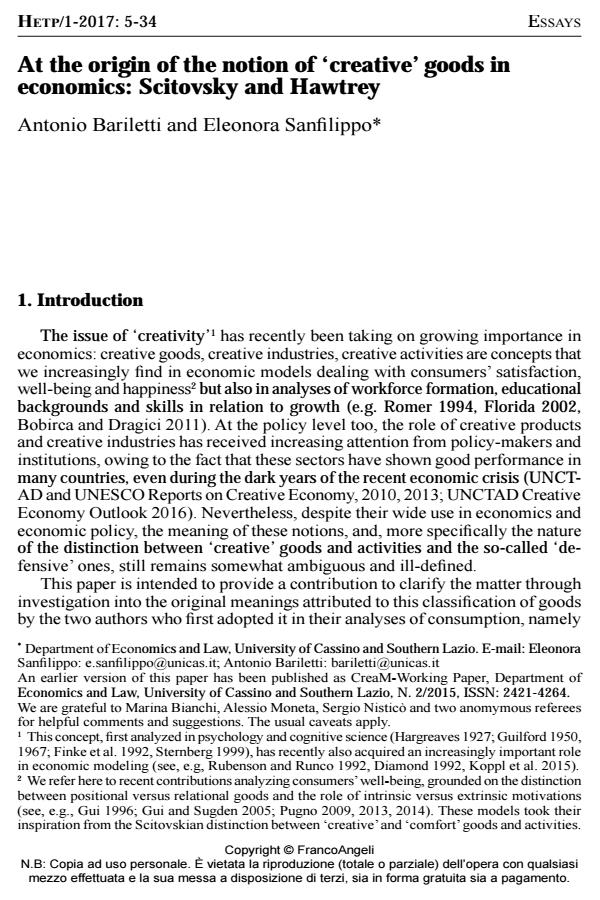At the origin of the notion of ‘creative’ goods in economics: Scitovsky and Hawtrey
Titolo Rivista HISTORY OF ECONOMIC THOUGHT AND POLICY
Autori/Curatori Antonio Bariletti, Eleonora Sanfilippo
Anno di pubblicazione 2017 Fascicolo 2017/1
Lingua Inglese Numero pagine 30 P. 5-34 Dimensione file 326 KB
DOI 10.3280/SPE2017-001001
Il DOI è il codice a barre della proprietà intellettuale: per saperne di più
clicca qui
Qui sotto puoi vedere in anteprima la prima pagina di questo articolo.
Se questo articolo ti interessa, lo puoi acquistare (e scaricare in formato pdf) seguendo le facili indicazioni per acquistare il download credit. Acquista Download Credits per scaricare questo Articolo in formato PDF

FrancoAngeli è membro della Publishers International Linking Association, Inc (PILA)associazione indipendente e non profit per facilitare (attraverso i servizi tecnologici implementati da CrossRef.org) l’accesso degli studiosi ai contenuti digitali nelle pubblicazioni professionali e scientifiche
The notion of ‘creativity’ has taken on growing importance in the recent economic literature on happiness, motivations and life-satisfaction. Starting from the seminal contribution by Scitovsky, the effects of ‘creative’ goods and activities on consumers’ well-being, in connection with cultural, sociological, psychological and educational aspects, have been analyzed. An increasing interest in these concepts has also recently been shown by policy-makers and international institutions (see, e.g., the UNCTAD/UNESCO Reports on Creative Economy, 2010, 2013, 2016). On the other hand, a clear analytical definition of this category of goods and activities and searching investigation into its peculiar characteristics in comparison with other types of products and activities, broadly defined as comfort or defensive ones, is still lacking in economic literature. This is why, despite its wide use, the nature of the distinction and the role it should play in economic analysis still remain somewhat vague and ambiguous. The aim of this paper is to provide a contribution to help clarify this distinction by reconstructing and comparing its original meaning and purpose in the works of Scitovsky (1976, 1992) and Hawtrey (1925) - the first economists who attributed a fundamental role to the notion of ‘creative’ goods in their analyses of consumption behavior.
Parole chiave:Scitovsky, Hawtrey, creative goods, consumers’ satisfaction, cultural policy.
Jel codes:B31, B41, D01, D11, Z11
- Pricing strategy as a leading predictor of the profitability in creative industry companies Katarína Remeňová, Mária Kmety-Barteková, Helena Majdúchová, Ľudomír Šlahor, in Strategic Management /2024 pp.29
DOI: 10.5937/StraMan2300053R - Keynes’s investment theory as a micro-foundation for his grandchildren Sergio Nisticò, in Economics 20200024/2020
DOI: 10.5018/economics-ejournal.ja.2020-24 - Artisan and Handicraft Entrepreneurs Aidin Salamzadeh, Samira Sadat Mortazavi, Morteza Hadizadeh, pp.217 (ISBN:978-3-030-82302-3)
Antonio Bariletti, Eleonora Sanfilippo, At the origin of the notion of ‘creative’ goods in economics: Scitovsky and Hawtrey in "HISTORY OF ECONOMIC THOUGHT AND POLICY" 1/2017, pp 5-34, DOI: 10.3280/SPE2017-001001